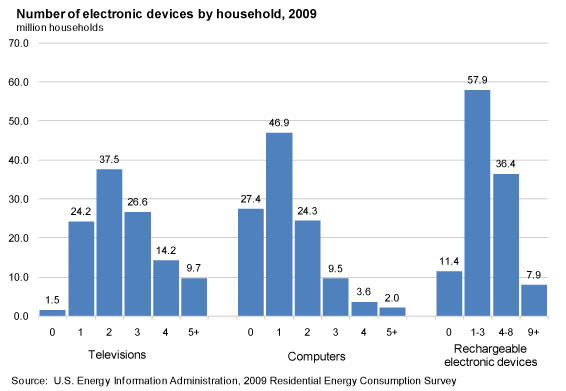
<a href="http://www.flickr.com/photos/declanjewell/3009680156/sizes/z/in/photostream/" target="_blank">DeclanTM</a>/Flickr
We all know we’re supposed to unplug our technological gadgets when we’re not using them, and back in the days when we only had a few home electronics—a TV here, a stereo there—that wasn’t so hard to do. But as our devices proliferate (see chart below), this formerly simple task has become increasingly annoying. Who wants to spend an extra 10 minutes every morning stalking around the house and finding phone chargers and cable boxes to unplug like we’re on some kind of weird easter egg hunt? And furthermore, would the energy savings from unplugging really be enough to make it worth the effort? I asked a few experts to weigh in.
According to Bruce Nordman, an energy efficiency researcher at the Lawrence Berkeley National Laboratory, as a general rule of thumb, the bigger—and older—the device, the more power it sucks up while it’s off. So it’s much more effective to unplug the decade-old TV in your guest bedroom than the phone charger that you bought last year. Another tip: “When you put your hand on the adaptor, if it’s hot, it’s using energy. If it’s not hot, it’s probably not using very much energy.”
 In general, though, Nordman doesn’t believe that unplugging modern appliances is really worthwhile, and he looks forward to the day when “smart” outlets and power strips (which are becoming more widely available) will do the thinking for us. In the meantime, “there’s probably better things to do with your time than unplugging things,” he said. “You could be changing out your lightbulbs or putting in insulation. That has a much higher return on investment.”
In general, though, Nordman doesn’t believe that unplugging modern appliances is really worthwhile, and he looks forward to the day when “smart” outlets and power strips (which are becoming more widely available) will do the thinking for us. In the meantime, “there’s probably better things to do with your time than unplugging things,” he said. “You could be changing out your lightbulbs or putting in insulation. That has a much higher return on investment.”
But an EPA spokeswoman I spoke to disagreed. She told me that the average household spends $100 a year on plugged-in devices even when they’re not being used directly. Nationwide, our idle gadgets and appliances suck up 100 billion kilowatt-hours of electricity—enough to power nearly 8.7 million homes—at a cost to consumers of about $11 billion. In addition to reminding me to choose only Energy Star-approved products, she singled out a few of the most power-hungry devices:
-
Cable boxes: The New York Times recently reported that our little cable boxes have an outsized energy footprint. Indeed, the EPA estimates that your box setups use about 500 kilowatt-hours per year, as much electricity as your fridge. If you have more than one TV, you can request a multi-room box, which allows you to ditch all but one of your DVR devices.
-
Computers: According to the EPA, computers account for 2 percent to 3 percent of overall household and office energy use in the US. As I’ve said before, sleep mode is good, but not as good as unplugging entirely. Laptops are more energy efficient, and screensavers save nothing.
-
Televisions: As a general rule of thumb, the more giant and awesome your TV, the more power it sucks, and the more diligent you should be about unplugging it. Flat-screen TVs use about twice as much power as their smaller cathode-ray counterparts.
-
Audio/video: All those iPod docking stations, home theaters, DVD players, and Blu-ray players add up. Cluster these devices on a smart power strip when you can. Many Energy Star-approved devices maintain their clock settings even when they’re powered off.
-
Game consoles: People tend to leave game consoles on all the time. A recent Carnegie Mellon University study (PDF) estimated that power use by home game systems in the US grew by 50 percent between 2007 and 2010 and now accounts for about 1 percent of total household energy use. Interestingly, the same study found that the Nintendo Wii uses significantly less energy than other popular systems (Microsoft Xbox and Sony Playstation). Although many consoles now automatically switch to a power-saving idle mode after a period of inactivity, even “sleeping” games use some energy.
- Digital picture frames. Who woulda thunk it? But since their purpose is to sit there and look pretty all day long like a normal framed photo, their energy use is significant. Find an Energy Star version or just use the old-fashioned kind.







